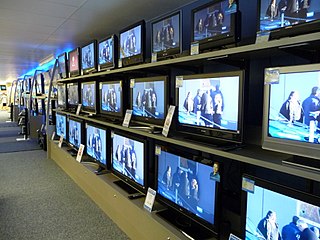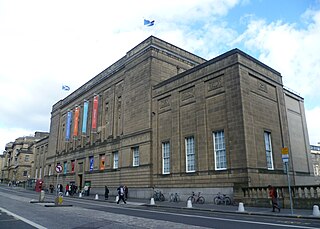The British Academy of Film and Television Arts is an independent charity that supports, develops and promotes the art forms of the moving image in the United Kingdom. In addition to its annual awards ceremonies, BAFTA has an international programme of learning events and initiatives offering access to talent through workshops, masterclasses, scholarships, lectures and mentoring schemes in the United Kingdom and the United States.

The National Science and Media Museum, located in Bradford, West Yorkshire, is part of the national Science Museum Group in the UK. The museum has seven floors of galleries with permanent exhibitions focusing on photography, television, animation, videogaming, the Internet and the scientific principles behind light and colour. It also hosts temporary exhibitions and maintains a collection of 3.5 million pieces in its research facility. The venue has three cinemas, operated in partnership with Picturehouse Cinemas, including an IMAX screen. It hosts festivals dedicated to widescreen film, video games and science, and has previously hosted popular film festivals, including the Bradford International Film Festival until 2014.

The Department for Digital, Culture, Media and Sport (DCMS) is a department of the United Kingdom government, with responsibility for culture and sport in England, the building of a Digital Economy, and some aspects of the media throughout the whole UK, such as broadcasting and internet.

The British Film Institute (BFI) is a film and charitable organisation which promotes and preserves filmmaking and television in the United Kingdom. The BFI utilises lottery funds to encourage film production, distribution, and education. It is sponsored by the Department of Digital, Culture, Media and Sport.
Stock footage, and similarly, archive footage, library pictures, and file footage is film or video footage that can be used again in other films. Stock footage is beneficial to filmmakers as it saves shooting new material. A single piece of stock footage is called a "stock shot" or a "library shot". Stock footage may have appeared in previous productions but may also be outtakes or footage shot for previous productions and not used. Examples of stock footage that might be utilized are moving images of cities and landmarks, wildlife in their natural environments, and historical footage. Suppliers of stock footage may be either rights managed or royalty-free. Many websites offer direct downloads of clips in various formats.
The UK Film Council (UKFC) was a non-departmental public body set up in 2000 to develop and promote the film industry in the UK. It was constituted as a private company limited by guarantee, owned by the Secretary of State for Culture, Media and Sport, and governed by a board of 15 directors. It was funded from various sources including the National Lottery. John Woodward was the Chief Executive Officer of the UKFC. As at 30 June 2008, the company had 90 full-time members of staff. It distributed more than £160m of lottery money to over 900 films. Lord Puttnam described the Council as "a layer of strategic glue that's helped bind the many parts of our disparate industry together."
The National Center for Jewish Film is a non-profit motion picture archive, distributor, and resource center. It houses the largest collection of Jewish-themed film and video outside of Israel. Its mission is to collect, restore, preserve, catalogue, and exhibit films with artistic and educational value relevant to the Jewish experience, and to disseminate these materials to the widest possible audience.
The UCLA Film & Television Archive is an internationally renowned visual arts organization focused on the preservation, study, and appreciation of film and television, based at the University of California, Los Angeles (UCLA). It holds more than 220,000 film and television titles and 27 million feet of newsreel footage, a collection second only to the Library of Congress in Washington, D.C. It has more media materials than any other university in the world.
The Film Archive Forum represents all of the public sector film and television archives which care for the UK's moving image heritage. It represents the UK's public sector moving image archives in all archival aspects of the moving image, and acts as the advisory body on national moving image archive policy.
The Screen Academy Scotland is a collaboration between Edinburgh Napier University and Edinburgh College of Art. It was opened in August 2005 by the then First Minister of Scotland, Jack McConnell, and is based in Edinburgh, Scotland. Both Edinburgh Napier and eca already had established film making courses, Napier's combined photography and film undergraduate BA launched Cannes prizewinner Lynne Ramsay on her journey to film directing. The Academy offers practical, project-based, postgraduate courses. A new Production Centre was opened in August 2006 by Napier Honorary Graduate Tilda Swinton. The Academy's first Director is Robin MacPherson FRSA, a BAFTA-nominated producer and formerly Development Executive for Scottish Screen, now Professor of Screen Media at Edinburgh Napier University where he is also Director of its Institute for Creative Industries and a Board member of Creative Scotland.

The BFI National Archive is a department of the British Film Institute, and one of the largest film archives in the world. It was founded as the National Film Library in 1935; its first curator was Ernest Lindgren. In 1955, its name became the National Film Archive, and, in 1992, the National Film and Television Archive. It was renamed BFI National Archive in 2006.
Media Archive for Central England(MACE) is the public sector regional film archive that collects, preserves and provides access to film, television and other moving image materials that relate to the governmental regions of the East Midlands and West Midlands (region).

The Ministry for Culture and Heritage Te Manatū Taonga (MCH) is the public-service department of the New Zealand government charged with advising the government on policies and issues involving the arts, culture, built heritage, sport and recreation, and broadcasting sectors, and participating in functions that advance or promote those sectors.
BBC Archives are collections documenting the BBC’s broadcasting history, including copies of television and radio broadcasts, internal documents, photographs, online content, sheet music, commercially available music, press cuttings, artefacts and historic equipment. The original copies of these collections are permanently retained but are now in the process of being digitised. Some collections are now being uploaded onto the BBC Archives website on BBC Online for viewers to see. The archive is one of the largest broadcast archives in the world with over 15 million items.
The city of Birmingham, England is home to an evolving media industry, including news and magazine publishers, radio and television networks, film production and specialist educational media training. The city's first newspaper was published in 1732.
The North West Film Archive in Manchester, is a moving image collection for the North West of England.
The British Academy Television Craft Awards is an accolade presented by the British Academy of Film and Television Arts (BAFTA), a charitable organisation established in 1947, which: "supports, promotes and develops the art forms of the moving image – film, television and video games – by identifying and rewarding excellence, inspiring practitioners and benefiting the public."
FOCAL International is the trade association representing stock footage companies, post-production facilities and individuals involved in the use of footage, still images and audio in all forms of media production. It represents more than 300 companies and individuals involved in media production, asset management, preservation of historical archives, film restoration and post-production.
The Indiana University Libraries Moving Image Archive (IULMIA) is a major repository for nontheatrical film, video, and related archival materials located in Bloomington, Indiana.













